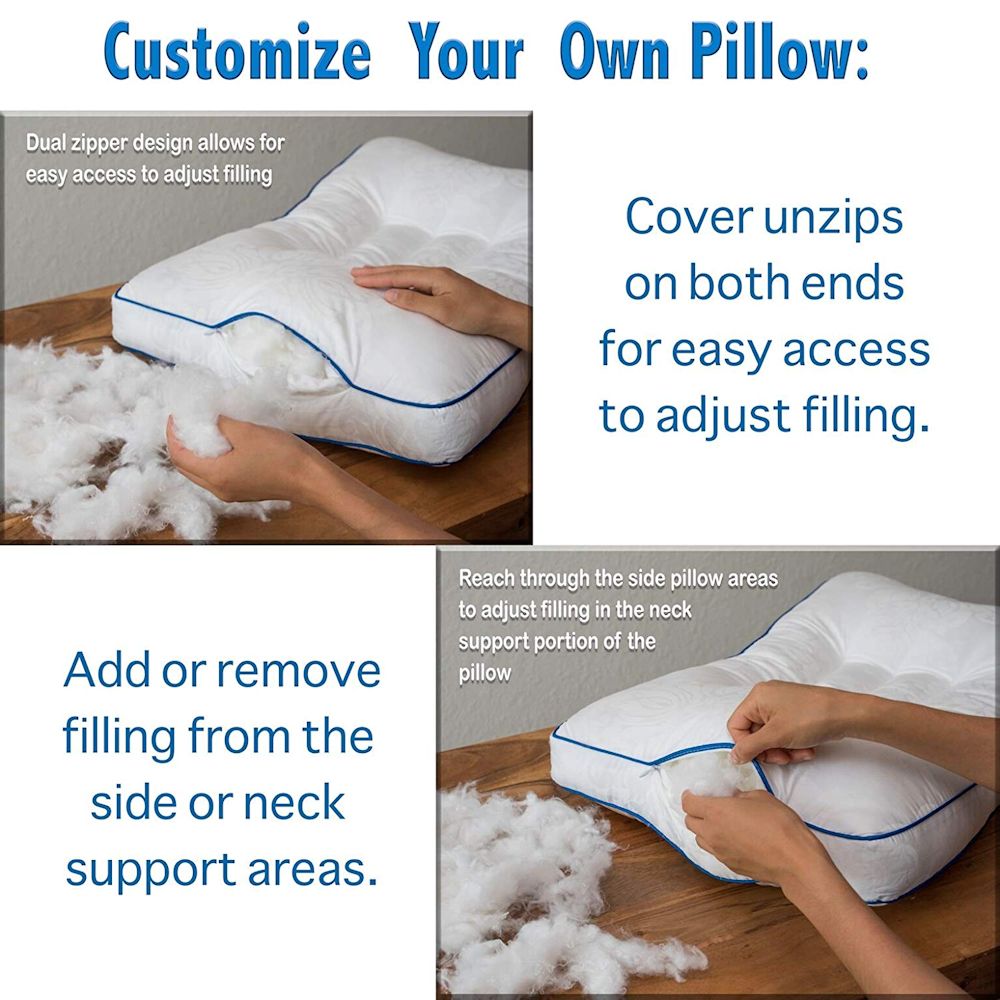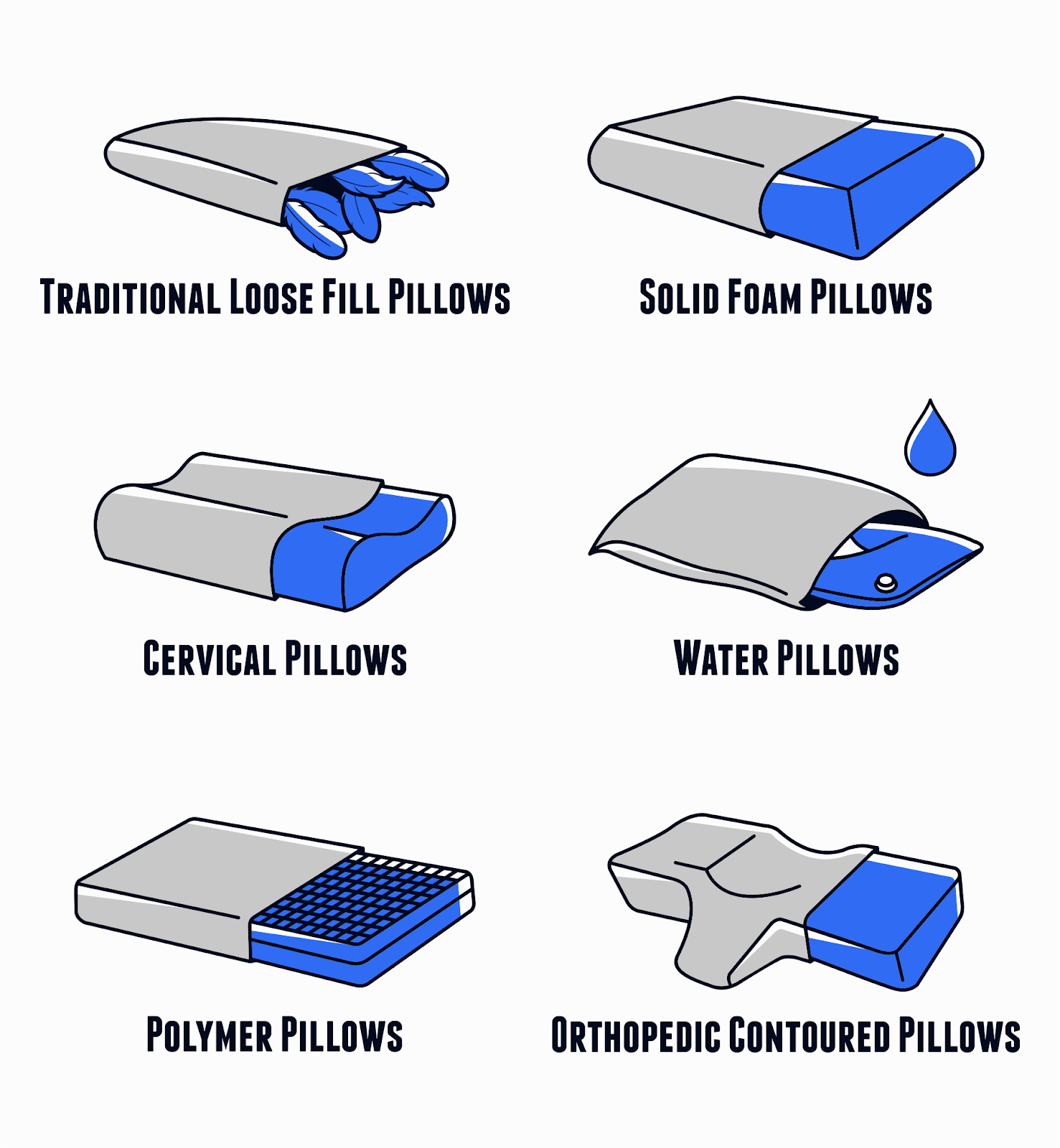Adjusting your pillow can reduce neck pain. It’s about finding the right fit for your comfort.
Neck pain can affect sleep and daily activities. The right pillow support can change that. Understanding how to adjust your pillow is essential for relieving neck pain. Many factors, like your sleep position and pillow type, play a role. This guide will show you how to adjust your pillow to support your neck better.
The goal is to wake up refreshed and pain-free. Let’s dive into the steps that can help you achieve a good night’s rest and a pain-free morning.
Choosing The Right Pillow
Experiencing neck pain can be a real discomfort, impacting your daily life. One of the key steps to alleviate neck pain is choosing the right pillow. The right pillow provides proper support and alignment for your neck and spine, ensuring a restful sleep. Let’s dive into the important aspects of selecting the right pillow for neck pain.
Types Of Pillows
There are various types of pillows designed to support different sleeping positions and preferences. Understanding these types can help you find the perfect match for your needs.
- Memory Foam Pillows: These pillows contour to the shape of your head and neck, providing personalized support. They are great for reducing pressure points.
- Contour Pillows: Shaped to cradle the neck and support the head, contour pillows are ideal for those who need extra neck support. They often help in maintaining the natural curve of the spine.
- Orthopedic Pillows: Specifically designed to correct body positioning, these pillows support the neck and spine alignment, which can reduce pain and improve sleep quality.
- Feather Pillows: Soft and moldable, feather pillows can be adjusted to fit your comfort needs. They provide good support but may not be suitable for those with allergies.
- Latex Pillows: Known for their firmness and support, latex pillows resist dust mites and mold, making them a great option for allergy sufferers.
| Type of Pillow | Pros | Cons |
| Memory Foam | Contours to shape, reduces pressure points | Can retain heat, may have an initial odor |
| Contour | Supports neck curve, maintains alignment | May feel too firm for some users |
| Orthopedic | Corrects positioning, reduces pain | Can be expensive |
| Feather | Soft, moldable | May trigger allergies |
| Latex | Firm, hypoallergenic | Heavy, can be expensive |
Material Considerations
The material of the pillow plays a crucial role in providing comfort and support. Different materials offer unique benefits and drawbacks.
- Memory Foam: This material is popular for its ability to conform to the shape of your head and neck, providing tailored support. It is durable and retains its shape over time.
- Latex: Natural latex is firm and supportive, offering excellent neck support. It is also resistant to dust mites and mold, making it a good choice for people with allergies.
- Down/Feather: These pillows are soft and comfortable, allowing you to mold them to your preferred shape. They provide less support compared to foam or latex but are ideal for those who prefer a softer feel.
- Polyester: An affordable and widely available option, polyester pillows are lightweight and easy to care for. They offer moderate support but may flatten over time.
- Buckwheat: Filled with buckwheat hulls, these pillows offer firm support and are adjustable. They are breathable and keep cool, but can be noisy when moved.
| Material | Pros | Cons |
| Memory Foam | Conforms to shape, durable | Retains heat, may have an odor |
| Latex | Firm, hypoallergenic | Heavy, expensive |
| Down/Feather | Soft, moldable | Less support, may trigger allergies |
| Polyester | Affordable, lightweight | Flattens over time |
| Buckwheat | Firm, breathable | Can be noisy, heavy |

Adjusting Pillow Height
Neck pain can disrupt your sleep and impact your daily life. One simple yet effective solution is adjusting the height of your pillow. Finding the right pillow height can support your neck properly and alleviate pain. This guide will help you measure and find the ideal pillow height for a pain-free neck.
Measuring Pillow Height
To adjust your pillow height, you first need to measure the current height of your pillow. Here are the steps to do it:
- Place your pillow on a flat surface.
- Use a ruler or measuring tape to measure from the surface to the highest point of the pillow.
- Note down the measurement in inches or centimeters.
It’s important to know the height because different sleeping positions require different pillow heights:
| Sleeping Position | Recommended Pillow Height |
| Back Sleeper | 4-5 inches (10-13 cm) |
| Side Sleeper | 5-7 inches (13-18 cm) |
| Stomach Sleeper | 1-3 inches (2.5-7.5 cm) |
Once you have your pillow’s height, compare it with the recommended heights above. This will give you an idea if your current pillow is too high, too low, or just right.
Finding The Ideal Height
Now that you know the recommended heights, it’s time to find the ideal height for your specific needs. Here are some tips:
- Try different pillows: If your current pillow is not adjustable, try using pillows with different heights to see what feels best.
- Use a folded towel: Place a folded towel under your pillow to increase the height temporarily. Adjust the folds until you find a comfortable height.
- Consider pillow materials: Memory foam pillows can provide better support and conform to the shape of your neck.
Remember, the ideal height should keep your spine in a neutral position. Your neck should align with the rest of your spine, not tilt up or down. This helps reduce strain and pain.
Also, listen to your body. If you wake up with neck pain, it might be a sign that your pillow height needs adjustment. Experiment with different heights until you find the one that gives you a restful sleep and pain-free mornings.
Pillow Firmness Matters
Neck pain can be a nightmare, but the right pillow can make a difference. Adjusting your pillow’s firmness is crucial. It supports your neck and ensures a good night’s sleep. Let’s dive into why pillow firmness matters for neck pain.
Soft Vs. Firm
Choosing between a soft or firm pillow can impact your neck pain. A soft pillow can provide comfort, but it may not offer enough support. Your head might sink too deep, causing your neck to strain. On the other hand, a firm pillow offers more support and keeps your neck aligned. This can reduce neck pain.
Here are some points to consider:
- Soft Pillows:
- Comfortable
- Less support
- Can cause neck strain
- Firm Pillows:
- More support
- Keeps neck aligned
- Can feel less comfortable initially
It’s essential to find a balance. A pillow that is too soft or too firm can both lead to discomfort. Testing different pillows can help you find the right firmness.
Personal Comfort Levels
Personal comfort is subjective. What feels comfortable to one person might not work for another. It’s important to consider your comfort level when choosing a pillow. Here are some tips:
- Test Different Pillows: Spend time testing different pillows. Lie down for a few minutes on each to see how your neck feels.
- Consider Sleeping Position: Your sleeping position affects your comfort. Side sleepers may need a thicker pillow, while back sleepers might prefer a medium-firm option.
- Check Pillow Height: The height of your pillow can affect comfort. Make sure your neck stays aligned with your spine.
Here’s a quick guide to help:
| Sleeping Position | Recommended Pillow Firmness |
| Side Sleeper | Firm to Medium-Firm |
| Back Sleeper | Medium-Firm |
| Stomach Sleeper | Soft |
Everyone has different preferences. Finding the right pillow firmness can take some time. Listen to your body and make adjustments as needed.

Positioning Your Pillow
Neck pain can often be traced back to poor pillow positioning. Adjusting your pillow correctly can greatly reduce discomfort and improve sleep quality. Whether you sleep on your back or side, the right positioning can make a significant difference. Here, we explore the best ways to position your pillow for neck pain relief, tailored for both back sleepers and side sleepers.
Back Sleepers
If you sleep on your back, your pillow should support the natural curve of your spine. This means keeping your head, neck, and shoulders in alignment. Follow these tips:
- Pillow Height: A low to medium-loft pillow is ideal. Your head should be aligned with your spine, not tilted forward or backward.
- Pillow Shape: Consider a contoured pillow. It provides support to the neck’s natural curve.
- Pillow Placement: Place the pillow under your head and neck, not your shoulders.
Using a table can help you choose the right pillow type:
| Pillow Type | Features |
| Memory Foam | Conforms to the shape of your head and neck, providing customized support. |
| Contour Pillow | Designed to support the natural curve of your neck, ideal for back sleepers. |
| Feather Pillow | Adjustable and can be shaped to fit your support needs. |
For additional support, you might place a small, rolled-up towel under your neck.
Side Sleepers
Side sleepers need a different pillow strategy to prevent neck pain. Your pillow must fill the space between your ear and shoulder. Here are some guidelines:
- Pillow Height: A high-loft pillow works best. It should keep your head in line with your spine.
- Pillow Firmness: Choose a firm pillow. It helps maintain neck alignment.
- Pillow Shape: A contoured or ergonomic pillow can provide tailored support.
Consider this table for choosing the right pillow:
| Pillow Type | Features |
| Latex Pillow | Firm and supportive, maintains shape well. |
| Buckwheat Pillow | Adjustable filling, conforms to your neck and head. |
| Body Pillow | Provides additional support for spine alignment. |
Using a body pillow can also help keep your spine aligned. Hug the body pillow and place it between your knees.
Using Additional Support
Adjusting your pillow for neck pain can greatly improve your sleep quality and overall well-being. Using additional support can make a big difference. Here are some effective ways to use extra support to alleviate neck pain.
Neck Roll
A neck roll can be a simple yet effective solution for neck pain. It provides extra support to the cervical spine. This helps maintain the natural curve of your neck while you sleep.
Here are a few benefits of using a neck roll:
- Reduces strain on the neck muscles.
- Prevents stiffness and soreness.
- Enhances alignment of the spine.
Using a neck roll is straightforward. Place it inside your pillowcase, beneath your regular pillow. Ensure it’s positioned at the base of your pillow, where your neck rests. You can also use it on its own if you prefer minimal support.
Here is a simple table to help you choose the right neck roll:
| Material | Firmness | Best For |
| Memory Foam | Medium to Firm | Consistent Support |
| Microbeads | Soft to Medium | Adjustable Support |
| Polyester Fiber | Soft | Light Support |
Choose a neck roll that matches your comfort needs and sleeping position. Experiment with different types to find what works best for you.
Lumber Support
Lumbar support is not just for your lower back. It can also benefit your neck. Proper lumbar support helps maintain the natural curve of your spine, which in turn supports your neck.
To use lumbar support effectively:
- Select a lumbar pillow that fits your body shape.
- Place it behind your lower back while sitting or lying down.
- Ensure it supports the curve of your lower spine.
Here are a few tips for choosing the right lumbar support:
- Look for adjustable straps if you need to secure it to a chair.
- Choose a breathable cover to stay cool.
- Opt for memory foam for personalized support.
Using lumbar support correctly can reduce neck strain. It keeps your spine in a neutral position, preventing additional stress on your neck muscles.
Combining neck rolls and lumbar support can provide comprehensive relief. Experiment with different setups to find the most comfortable and effective solution for your neck pain.
Maintaining Pillow Hygiene
Neck pain can often be alleviated by adjusting your pillow. But maintaining pillow hygiene is just as important for comfort and health. Clean pillows prevent dust mites, bacteria, and allergens, which can cause or worsen neck pain. Proper hygiene ensures your pillow remains supportive, enhancing your sleep quality.
Cleaning Tips
Regular cleaning keeps your pillow fresh and free from harmful microorganisms. Here are some practical tips:
- Read the Label: Always check the care instructions on the pillow’s label. Different materials require different cleaning methods.
- Washing: Most pillows can be washed in a machine. Use a gentle cycle with mild detergent. For extra freshness, add a cup of baking soda.
- Drying: Dry pillows completely to avoid mold. Use a dryer on low heat. Add clean tennis balls to keep the pillow fluffy.
- Spot Cleaning: For stains, use a mild soap and a clean cloth. Gently blot the stain until it’s gone.
- Protective Covers: Use pillow protectors to shield against dust and sweat. Wash these covers monthly.
| Material | Washing Frequency | Special Instructions |
| Cotton | Every 3 months | Use mild detergent |
| Memory Foam | Spot clean as needed | Do not machine wash |
| Down | Every 6 months | Dry thoroughly |
Replacement Frequency
Even with regular cleaning, pillows need replacing to maintain neck support. Here’s how often you should replace them:
- General Rule: Replace pillows every 1-2 years. Over time, pillows lose their shape and support.
- Signs of Wear: If your pillow is lumpy, flat, or has a persistent odor, it’s time for a new one.
- Material Specific:
- Memory Foam: Replace every 18-36 months. Memory foam can degrade faster.
- Down or Feather: Replace every 2-3 years. These materials can clump and lose support.
- Polyester: Replace every 6-24 months. Polyester pillows flatten quickly.
| Material | Replacement Frequency |
| Memory Foam | 18-36 months |
| Down or Feather | 2-3 years |
| Polyester | 6-24 months |
Regular cleaning and timely replacement of pillows are crucial for preventing neck pain. A clean, supportive pillow enhances sleep quality and overall health.
Consulting A Professional
Dealing with neck pain can be frustrating. Sometimes, adjusting your pillow might not be enough. In these cases, consulting a professional can provide the relief and guidance you need. Professionals can pinpoint the exact cause of your neck pain and recommend the best solutions. They can also suggest the right pillow type for your needs. Understanding when to seek help and which specialist to consult is crucial for effective pain management.
When To Seek Help
Not all neck pain requires professional help. But there are certain signs that indicate it’s time to consult a specialist. Here are some situations where seeking help is necessary:
- Persistent Pain: If you have neck pain that lasts more than a week, it’s time to see a professional.
- Severe Discomfort: If the pain is severe and disrupts your daily activities, you need expert advice.
- Limited Mobility: If you cannot move your neck freely, professional help is required.
- Accompanying Symptoms: If you experience headaches, numbness, or tingling along with neck pain, it’s a sign of a serious issue.
Recognizing these signs early can prevent the condition from worsening. Here’s a simple table to summarize when to seek help:
| Symptoms | Action |
| Persistent pain for over a week | Consult a professional |
| Severe discomfort | Seek expert advice |
| Limited neck mobility | See a specialist |
| Headaches, numbness, tingling | Immediate professional consultation |
Types Of Specialists
Different specialists can address neck pain in various ways. Understanding the types of specialists can help you choose the right one:
- Chiropractors: They adjust your spine and neck to relieve pain. They use manual manipulation techniques.
- Physical Therapists: They use exercises and stretches to improve neck strength and flexibility. They also provide guidance on posture and pillow use.
- Orthopedic Doctors: They specialize in bones and muscles. They can diagnose and treat severe neck issues. They might suggest imaging tests for a detailed diagnosis.
- Neurologists: They deal with nerve-related problems. If your neck pain involves nerve issues, they can provide the best treatment.
Here’s a quick reference table for the types of specialists:
| Specialist | Focus Area |
| Chiropractor | Spine and neck adjustments |
| Physical Therapist | Exercises, stretches, posture guidance |
| Orthopedic Doctor | Bones and muscles, severe issues, imaging tests |
| Neurologist | Nerve-related problems |
Choosing the right specialist depends on your symptoms and the severity of your neck pain. Consulting the appropriate professional ensures you receive the best care.

Frequently Asked Questions
How Can I Adjust My Pillow For Neck Pain?
Adjust your pillow to support the natural curve of your neck. Avoid too high or too low positions.
What Type Of Pillow Is Best For Neck Pain?
Memory foam or cervical pillows are often best. They provide good neck support and maintain proper alignment.
How High Should My Pillow Be For Neck Pain?
Your pillow should be high enough to keep your neck aligned with your spine. This usually means a medium loft.
Can Sleeping Position Affect Neck Pain?
Yes, sleeping on your back or side can help. Avoid sleeping on your stomach as it strains the neck.
Conclusion
Adjusting your pillow for neck pain can make a big difference. Choose the right pillow for your sleeping position. Make sure your neck stays aligned with your spine. Experiment with pillow height and firmness. Regularly check and replace worn-out pillows.
Small changes can lead to better sleep and less pain. So, take action today and enjoy a pain-free night. Sleep well and wake up refreshed. Your neck will thank you!
